An Epigraph, Which May Be Innocently Mistaken For Deep Eastern Wisdom:
A “trope” isn’t a bad thing. If we (fashionably) describe a show as “trope-y” we might mean stereotype-ish. Stereotypes usually come from archetypes, and stereotypes aren’t inherently a bad thing, but they often end up being tropey…in the undesirable way. Then there’s typecasting, which on-screen Asians contend with often, and we’ll get into that, below. Fade up to:
Interior Chinatown is a new series on Hulu based on the 2020 novel by Charles Yu. A satire in the form of a crime thriller, written in screenplay format, exploring Asian American tropes as they are typically depicted on television, is now a show depicting Asian Americans on television. Over a three-part series I’ll look at Interior Chinatown in relation to some films and TV shows which are similarly playful with genre, although you might not immediately think of them as Asian American/AAPI movies….
Your Motivation Is “To Humanize”
Every episode in the 10-episode season is titled after a familiar Asian-associated type in American pop culture, especially Asian dudes. Episode 1: “Generic Asian Man” introduces us to Willis Wu, a Chinese American guy played by Jimmy O. Yang. Willis works in a Chinese restaurant, is awkward, and narrates the story with hyper-conscious awareness of his uniquely un-exciting place in the universe.
(I’m writing this while watching Interior Chinatown in real time, so here will deal mainly with episodes 1 through 4. Parts II and III will focus on episodes 5-7, 8-10. Being familiar with the novel and also as someone who lives this exact niche, I’m pretty confident in the direction the show is going and do not expect much surprise or spoilage, but instead am enthusiastically over-analyzing the journey that gets us there.)
Willis’s situation is instantly recognizable as a posture held by many actual people and also “the nerdy protagonist” in countless rom-coms and coming-of-age stories. When a martial arts battle jumps off spontaneously in the middle of the lunch rush, I thought of the obvious similarities to Return of the Dragon and Rush Hour, but I also recalled my favorite Asian American-ish genre film of the past five years, Birds of Prey (and the Fantabulous Emancipation of One Harley Quinn).
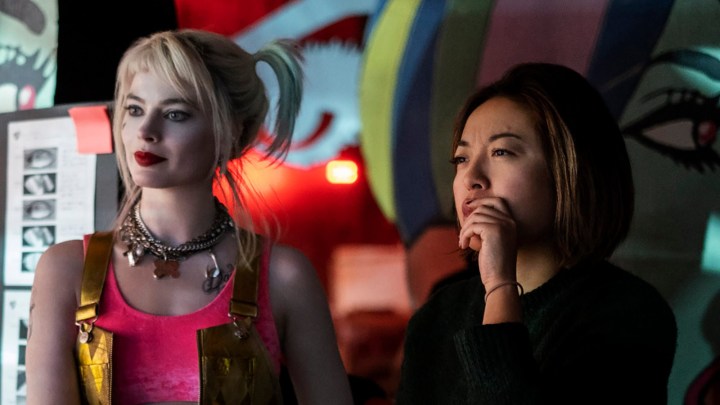
I wrote at the time of its release that Birds of Prey is aesthetically a very Asian American movie. Not because it’s got a ton of Asian actors in it, but because the Cathy Yan-directed DC superhero romp draws from a subset of films and cinematic vocabulary that enables it to hum with a distinctly Asian American aesthetic. BOP is an underrated comedy that, like Interior Chinatown, adopts the motifs of formulaic cop shows and consciously pays tribute to an Asian American version of grinding through life in New York/Gotham City.
A recurring pain point for Asian American film and TV artists, and part of why we offer perspective pieces here at The Nerds of Color, is the essential challenge of being seen as human beings. We are typically treated as resources for tech support or sex, elsewise we find ourselves conveniently invisible. At the same time, everyone would like to go to Chinatown for the food.
Willis is defined more by his lacks than his wants, but he does have the sense that he’s in a somewhat directionless movie. Perhaps the theme is self-discovery. The superhero origin story is a present touchstone in Interior Chinatown. The Chinese-American dude protagonist empathizes with the costumed vigilante’s sense of duty compounded with isolation (in a realistic genre, this might be delusional entitlement, in a magical-realist context, it’s destiny) and with the status of being seen as other-than-a-person. Willis doesn’t have a big plan to rise above his station, but to be fair he’s working on just being noticed. In this basic human thing, Willis and Lana’s searchings reminded me of Harley Quinn and friends’ “fantabulous” arc toward agency.
Also, Harley lives above the Chinese restaurant, and there’s that whole sequence with Huntress and Cassandra Cain, the script pages for which certainly may’ve begun with INT. CHINATOWN.
Before launching into his obligatory fight scene, Willis meets Detective Lana Lee, played by Chloe Bennet, who is investigating a murder with melodramatic police-procedural intensity, much like Rosie Perez in Birds of Prey.
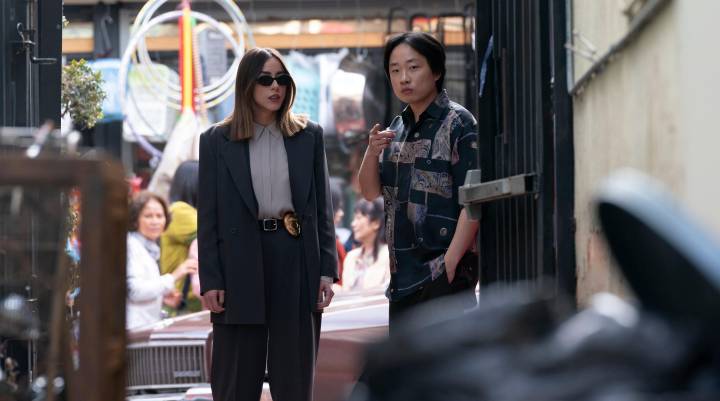
Pitch: It’s The Matrix But Keanu Is….
The events of Episodes 2 and 3, “Delivery Guy” and “Tech Guy” strongly echo The Matrix, both in structure and theme. Willis exists in a kind of augmented reality, and is fished out of drudgery (via mysterious phone calls) by an enigmatic woman who bridges the real and the imagined.
The Matrix is one of those movies, like Star Wars and Gremlins, that draws from distinctly East Asian source material and brings it to an American context, hence, Asian American movie. Keanu Reeves, ever the flexible template for any identity the audience wishes to imprint on him, is both Asian-evocative and not, ethnically-mixed and universally-appealing. Like, whoa, duh.
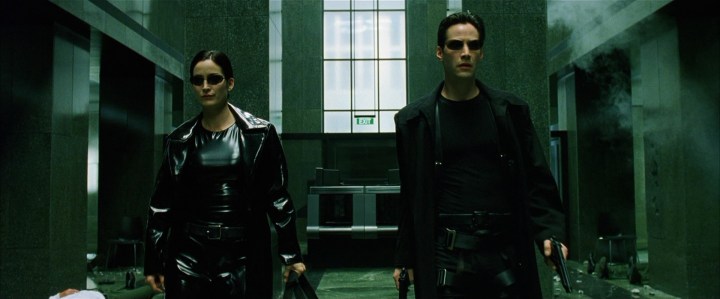
Back to the typecasting point: Chloe Bennet was a maverick secret agent in Agents of S.H.I.E.L.D., here she’s a maverick cop, channeling Trinity to Willis’s hap-free Neo. The type-ing is the point in Interior Chinatown, which makes every moment a meta-moment, occasionally to the point of over-preciousness. “I’m sorry I called you a sidekick,” Willis says to Lana, giving unsolicited notes on the script.
And, as in The Matrix, Lana’s call leads Willis into a parallel world of cinematic adventure. Thus far (and again, am in mid-binge) the show also indulges, with a wink or not, in shouty signals for the Alluring Asian Woman trope: Detective Lee appears on the scene in a halo of soft light and dancing hair that is, well, tropey. At a Matrix-reminiscent meeting with Willis at night, she has a toothpick in her mouth for no real reason. There are callouts to Wong Kar Wai films (In the Mood For Love, Chungking Express) in several beguiling camera compositions centering Lana’s loveliness, and again when she rises to karaoke Yaz’s “Only You,” the song in the swoony closing shot of Fallen Angels.
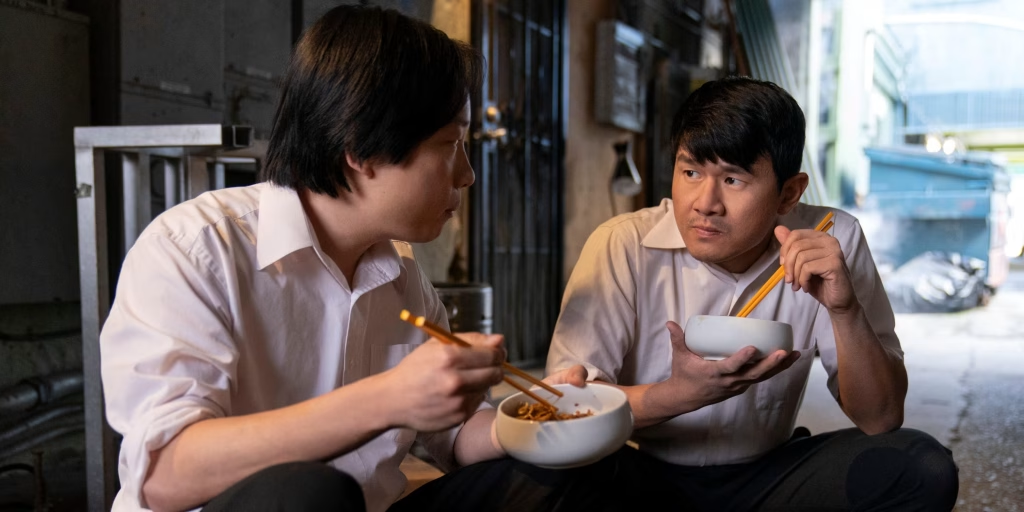
But We Are Living In a Post-Shang-Chi World, So…?
But it’s not all ogling proto-romantic awkwardness. In Episode 4: “Kung Fu Guy” there are also the cultural set pieces which signify Asian American life, like those expressed with joy in the first half of Shang-Chi, e.g. the karaoke, the sumptuous connective moments over food from takeout boxes, identifying with the martial arts TV hero (in this case, Willis’s departed brother)
Most of my distinctively Asian American hangups are detailed in this piece written before the opening of Shang-Chi (first posted during the peak of the Covid pandemic, it’s lengthy), and all said hangups are fully engaged in Interior Chinatown. Of particular thorniness are the spectrum of difficulties surrounding Asian American gender roles, that is, broadly speaking, the conflicting perceptions of Asian males and Asian females, as heavily informed by pop culture.
Interior Chinatown the novel came out in 2020, that endless year before Shang-Chi unceremoniously yet undeniably altered the landscape, at least for the niche of people who follow this sort of thing. With Asian cultural literacy expanded (incrementally) by recent popular works like Everything Everywhere All At Once, Beef, Kim’s Convenience, etc. — do all the issues raised by Interior Chinatown still hold sway over our daily lives?
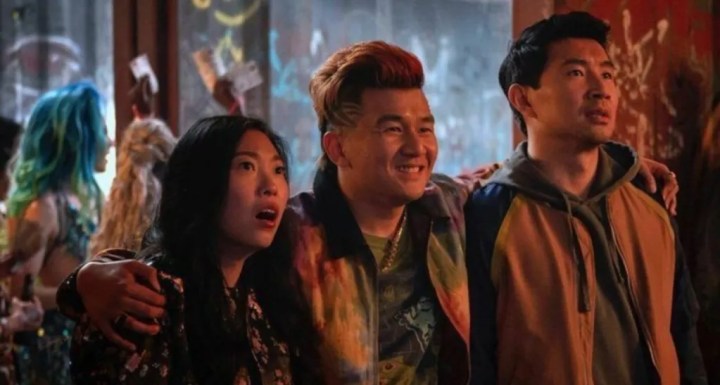
In places, the show has the flavor of a period piece, and some of the troublesome tropes targeted feel elementary (to cite another TV mystery series with an Asian American female lead). But then, from personal experience I’m immersed in these thought bubbles, and have to always take into account the significant audience for whom it’s eye-opening.
The setup of the show certainly runs the risk of indulging in narcissistic navel-gazing (in the “dude questions his own existence every time he’s existing” sort of way) which is one reason it’s cool that the novel made such heavy use of screenplay format. Movie scripts create dialogue and allow for paradoxical difference of viewpoints by adjacent characters, as opposed to first-person novels which run the risk of one person’s POV aggressively gaslighting the universe.
A Managed-Expectation Plea, in the Form of Fortune Cookie-Condensed TLDR:
At MINIMUM can we get a broader American audience to learn about the Cantonese-Mandarin thing? The specific contexts in which Cantonese and Mandarin are alternately used in this show are both realistic and revealing of character, I opine, and the phonemes do have sharp distinguishable differences, even if you don’t know what’s being said. I have some mediocre Mandarin and practically no Cantonese, but I always appreciate the contrast of northern and southern vibes when trying to read a room.
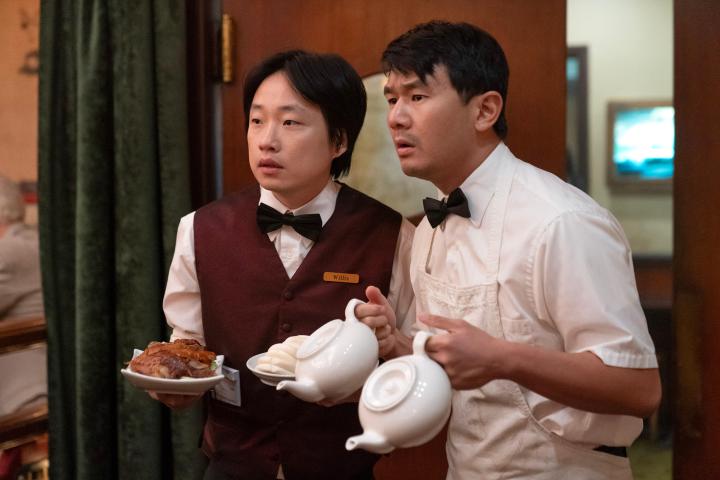
JIMMY O. YANG, RONNY CHIENG
In the next exciting blog-isode of Interior Chinatown vs. the Asian American Canon, I’ll look at episodes 5-7 of the series and dive into NYPD Blue and Law & Order: SVU, two of the cop shows which heavily influence the shape of Yu’s novel and are delightfully satirized in the Hulu series.

